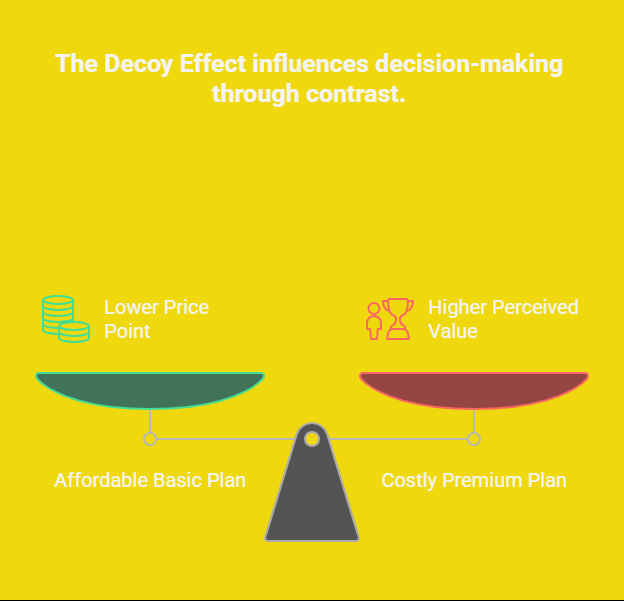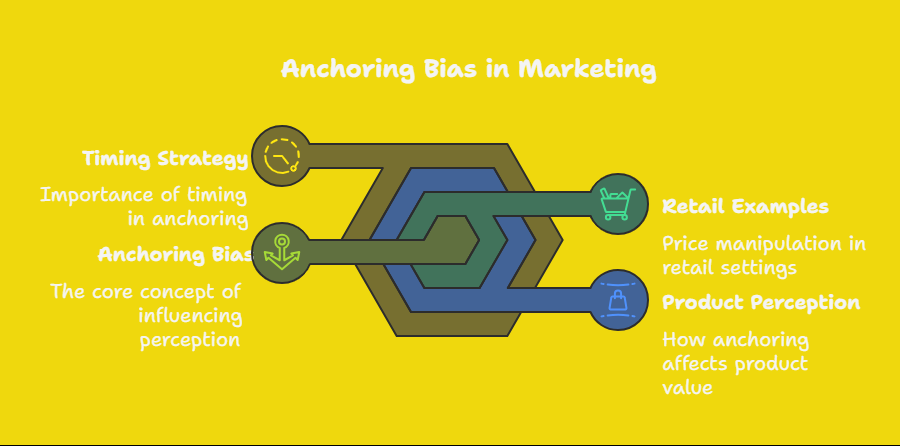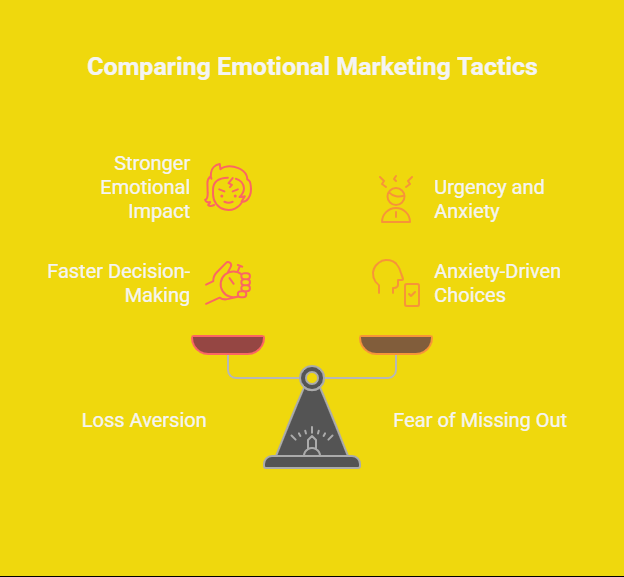
23 Jul 2025
The Marketer’s Playbook: Psychology of Modern Marketing for Smarter Campaigns
Table Of Content
Table of Contents
We like to think that we’re pretty good at making smart choices — especially when money is on the line. A reasonable consideration of the pluses and minuses, an intelligent assessment of the cost-benefit ratio. But in reality, a great deal of what we describe as “choice” is well-worn by the time we realize that we are choosing.
The most effective marketing today doesn’t simply deliver a message — it frames it. By mapping onto how human brains naturally perceive information, weigh risk, and avoid regret, it reinvents perception itself. And the most successful campaigns? They never sell the thing directly. They’re selling the context that the product feels like the path of least resistance.
In the blog, we delve into three psychological hacks that achieve this: “the Decoy Effect, Anchoring Bias, and Loss aversion”. They don’t beg for attention; instead, they subtly redefine it in their own unique way.. And when you understand how they operate, you’ll begin to recognize them everywhere — from streaming subscriptions to your most recent impulse buy. Let’s dissect them — not as gimmicks, but as the foundation of smart marketing.
The Decoy Effect: A Consumer Psychology Marketing Tactic
The Decoy Effect doesn’t convince you in the obvious sense. It simply shifts the way you perceive it by altering the way options are presented.

For example, let’s say you’re trying to decide between two pricing plans. One is affordable but basic. The other is costly but premium. You hesitate. And then there’s the third option, which is oddly priced, somewhere in between, but clearly inferior to the most expensive option. Now, all of a sudden, the premium plan appears to be the smartest deal on the page.
That middle choice was never designed to be selected. It was put there to make the more expensive plan seem more valuable in contrast.
This tactic is relied on by marketers in everything from menu design to pricing goods and services. A small popcorn costs ₹120, a large costs ₹200 — but now there’s a medium, at ₹190. It’s very comparable to the large, but not as filling. And suddenly, the big one seems like a fantastic offer. You haven’t learned something new. You have just been convinced– not by persuasion but contrast. The decoy effect is a subtle but efficient tool. It doesn’t sell you the product. It guides you through the process of making decisions about the product. The Decoy Effect is a delicate but sharp instrument. It doesn’t sell the product. It’s selling the decision-making process around the product.
Anchoring Bias: Cognitive Bias Marketing in Action
Anchoring is based on a straightforward principle: the first figure you have in mind becomes your reference point. Everything else is measured in relation to it, whether it’s relevant or not.

It’s the reason why “₹7999 slashed to ₹3999” makes it seem more of a bargain, even though ₹3999 was always its price meant for six months. The original ₹7999 isn’t there to ground out the actual value of the product — it’s there to lead your expectations to the moon, so that the true price feels like a victory.
It’s not just a retail ploy. Anchoring influences how we perceive hotel rooms, smartphone specs, and investment plans. The first time you show someone a handbag for ₹1.5 lakh, one for ₹60,000 becomes more acceptable. Reverse it, and it seems like too much.
The trick lies in timing. Anchors lose strength if they’re introduced too late, which is why, on a page, the best products appear first, and why car dealers always show you the top model first. After the anchor is fixed, all the other numbers loop around that.
Anchoring doesn’t alter the product — it transforms how “expensive,” “affordable,” or even “fair” feels like. And in marketing, that change in sentiment is everything.
Loss Aversion: FOMO Marketing Strategy Explained
Of all the human biases, loss aversion may be the strongest because it taps into something primal. People feel the pain of losing something about twice as strongly as the pleasure of gaining the same thing. Marketers play on that to create urgency, not just by invoking scarcity, but by framing. They don’t say “Get 20% off” but “You’re losing 20% if you don’t act now.” The ask is the same — the emotional reaction is not.

That’s why websites show “Only 2 left in stock,” why you receive emails about loyalty points expiring, and why travel platforms highlight “5 people are viewing this hotel right now.” These messages aren’t selling the product. They’re selling the fear of losing the chance to get it.
Loss aversion isn’t just a button-pushing way to get conversions. It speeds up decision-making. It replaces the calm logic of comparison with the anxiety of missing out. And for marketers, it’s a lever that activates attention faster than any coupon code ever could.
What Smart Marketing Looks Like: The Psychology of Modern Marketing in Action
You might think that great marketing is all about slapping together a catchy slogan, some flashy visuals, and clever copy. But in truth, the most effective strategies are based on something much more fundamental — how people reason. You don’t need to manipulate; you need to understand.
When you understand how people compare their choices, craft value, and shield themselves from regret, you no longer need to guess what will make something succeed and can start designing experiences that naturally appeal to your audience’s instincts.
The Decoy Effect changes the context of the decision. Anchoring sets the stage. Loss aversion fuels action. When used responsibly, these tools are not deceptive. They empower customers to buy with confidence — and enable brands to articulate value with clarity and conviction.
The Choice Was Never a Fair One: Understanding the Psychology of Modern Marketing
What seems like a rational decision is often an environment carefully shaped. The winners aren’t always the loudest or the cheapest. They are the ones who know how decisions are made in the real world — messy, emotional, rough-edged, and full of shortcuts.
Marketing is not about increasing pressure. It’s removing friction from the outcome you’re wanting to influence. So the next time you’re left scratching your head about why a customer didn’t convert, asking what you said probably shouldn’t be the first question that comes to mind. Ask how it felt to choose you.
FAQs
1. What is the Decoy Effect in Consumer Psychology Marketing?
The Decoy Effect is a consumer psychology marketing tactic where an additional, less attractive option is introduced to make another product appear more appealing. It subtly guides customer decisions without selling the product directly, influencing perception and choice.
2. How does Anchoring Bias work in Cognitive Bias Marketing?
Anchoring Bias in cognitive bias marketing occurs when the first piece of information (like a price or feature) sets a reference point for customers. All subsequent decisions are judged relative to this anchor, shaping perceptions of value, affordability, and fairness.
3. Why is Loss Aversion used in a FOMO Marketing Strategy?
Loss aversion is a key element of FOMO marketing strategy. It emphasizes potential losses rather than gains—like “Only 2 items left”—creating urgency. By triggering the fear of missing out, it accelerates decision-making and drives conversions.
4. What is Consumer Psychology Marketing and how does it influence buying decisions?
Consumer psychology marketing studies how customers think, feel, and make purchasing decisions. It focuses on understanding motivations, preferences, and behavioral patterns so brands can design campaigns that naturally guide consumers toward desired actions.
Also Read:- Marketing Before the Click: The Secret to Advertising in Today’s Online World
Leave a Reply
Your email address will not be published. Required fields are marked *












Comments